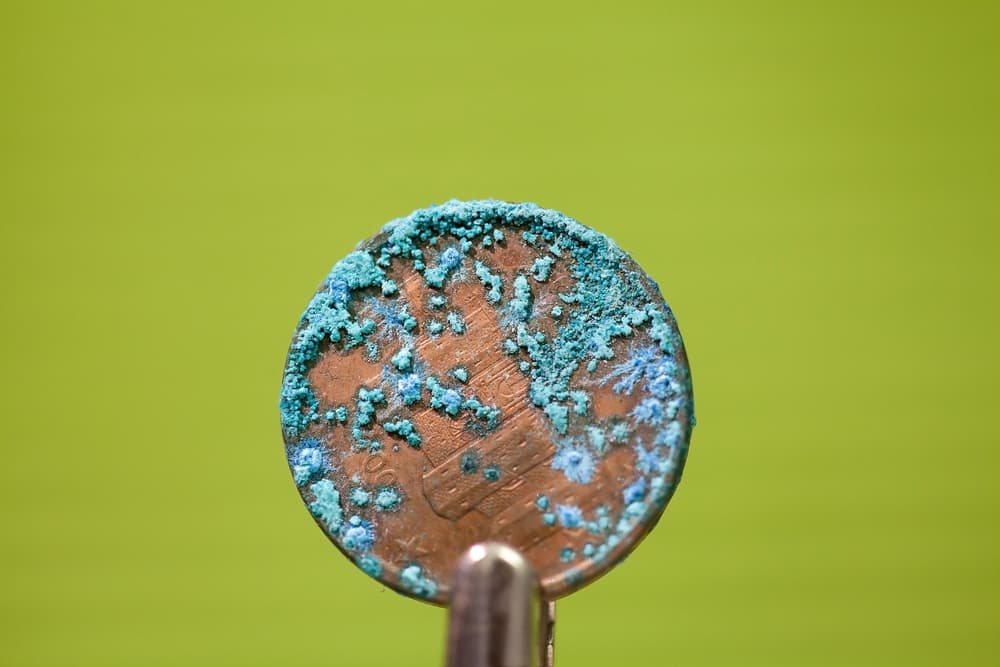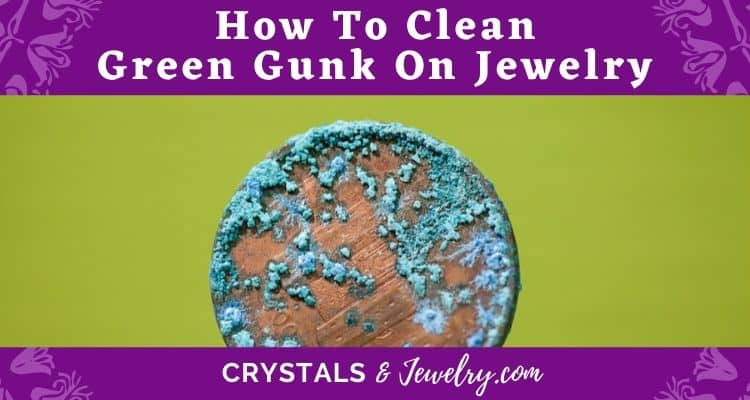If you own a piece of jewelry, for sure you have experienced getting it out of your jewelry box after a long time of not using it, only to discover that it has green gunk all over it.
This green gunk can appear on the clasps of necklaces and bracelets, on the clips of earrings, and just about anywhere on your valuable jewelry.
Any metal surface on your jewelry is not safe from this unsightly green gunk.
You will also notice that parts of the jewelry that have the most green gunk are parts that often come in contact with your skin.
These parts are more prone to accumulating sweat and dirt, as well as cosmetic products that you apply.
If you’re reading this, you’re probably one of those people who love wearing jewelry but hate seeing the green gunk all over it.
Getting this green gunk on your precious pieces does not mean that you have to throw them away!
Fortunately, there is a way to remedy this. In this article, you will discover effective ways to help clean green gunk on jewelry.

What is That Green Gunk Called, Anyway?
The green gunk that you can see on jewelry and other metal pieces is called verdigris.
It’s the natural patina that forms when copper oxidizes. Verdigris also forms when it comes in contact with moisture and other forms of pollutants over time.
These pollutants include bodily fluids like sweat and oils, as well as cosmetic and hair products.
This green gunk is not only unsightly but also a pain to clean, especially from exquisitely designed antique costume jewelry.
It’s also a corrosive agent, which means that it eats away small bits of metal if you don’t remove it right away.
Verdigris can grow on pure and alloy forms of bronze, brass, and copper, as well as items that are gold or silver plated.
When a small part of the plating is worn very thin, chipped, or removed, the surface is a ripe breeding ground for verdigris to form.
If you store your good jewelry with a piece that already has verdigris on it, it will easily get infected with this green gunk as well.
Doing These Things Will Help Clean Green Gunk on Jewelry
1. You can help clean green gunk on jewelry with the use of a toothpick.
Scrape small amounts of the green gunk from tiny spots or hard to reach areas of your jewelry.
This will work in the tiniest or tightest spots, like the clasps or chains.
2. If you’re trying to clean a bigger area, you can replace the toothpick with a pencil eraser or a toothbrush.
Use a brush with soft bristles so as not to scratch the surface of your jewelry, especially if they are vintage or antique pieces.
Use it dry and brush it on the green gunk, removing as much as you can without damaging the jewelry.
Erasing the green gunk with a pencil eraser can also do the trick, especially if the green gunk is not old and tough.
3. You can also use metal polish to help clean green gunk on jewelry.
After brushing off as much green gunk as you can with your toothpick, toothbrush, and pencil eraser, you can move on to using metal polish.
Metal polishes can be purchased in most hardware stores. They are slightly abrasive creams that will help clean green gunk on jewelry as well as dirt from other kinds of metals.
Just squeeze a pea-sized amount of the polish on a soft and clean cloth and rub it on your jewelry with green gunk.
Scrub it for about 30 seconds and check for any changes. You may need to do this a couple of times depending on how much green gunk there is.
Finish polishing your jewelry pieces until you’re satisfied with how it looks.
If using metal polish does not completely remove the green gunk, don’t panic. There are still some home chemical treatments which you can try.
4. Vinegar can help clean green gunk on jewelry.
You should know that vinegar is not only used for cooking but for many other cleaning purposes as well.
Vinegar can be used to clean green gunk on your jewelry.
Pour some white vinegar in a cup or a bowl and soak your verdigris-filled jewelry for about half an hour.
After the half hour is through, you can pull your jewelry out and brush it again with a toothbrush. Rinse it well in water and then dry it with a soft and clean cloth.
However, don’t do the vinegar soak for jewelry with rhinestones that have foil backings, pearls, or fake pearls.
If the green gunk is only present in some parts of your jewelry, you can still do the vinegar method. But instead of soaking the whole thing in the vinegar, you can use a cotton ball instead.
Dip the cotton ball in the vinegar and leave it on the part of the jewelry that only has verdigris. This will protect the other parts of your jewelry that should not be exposed to vinegar.
5. Did you know that ketchup can also be used to help clean green gunk on jewelry?
Ketchup is also acidic and can stay in place. The same caution with using vinegar should be taken when using ketchup.
Lay your jewelry on a paper towel and put a little ketchup on the green gunk. Allow it to sit for about 30 minutes. Rinse it well afterwards and allow it to dry thoroughly.
Things That You Can Do to Prevent Green Gunk Buildup
Proper storage of your precious jewelry will prevent damage from green gunk.
Try not to expose them to moisture. Make sure that before you put your jewelry away, there’s no residue makeup, dirt, or moisture present.
It’s strongly advised that you don’t pile your jewelry together and leave it untouched or unused for months or years.
Make sure that you get your jewelry out of storage once in a while even if you don’t plan on using or wearing them.
This will allow you to check them for green gunk in its earliest stages. The sooner you catch early signs of verdigris, the sooner you can start removing it!
Verdigris occurs when jewelry is not properly protected or cared for against the elements. In order to avoid verdigris, your jewelry should be kept in a cool and dry place.
Never store them when they’re damp or dirty. If you can get the small silica gel packs, make sure you store your jewelry alongside them to absorb any excess moisture.
If you’re hitting the beach or hanging out in the pool, it’s best to remove your jewelry first or not wear them at all to avoid water damage.
Verdigris can spread from one piece of jewelry to the next. This is why it’s best to store each piece separately.
This way, in case one piece of jewelry gets verdigris, it will not affect the rest of your jewelry collection.
As for keeping the verdigris from coming back, you can try coating the part that gets the most moisture with some nail polish.
Coating it will prevent sweat and skin oils from coming in contact with the metal. It’s not a permanent coating, so you will have to do this periodically.
You could bring your jewelry to a professional to have it professionally repaired and restored. But this is usually very expensive to even be worth it.
Still, the best way to not deal with green gunk on jewelry is to prevent it from forming!
What to Do with Green Skin from Jewelry?
You find the perfect earring, necklace, bracelet, or ring and you wear it all day every day. But your skin turns a shade of green when you take it off.
Don’t worry, this is not verdigris on your skin but just a reaction of your skin with the copper element in the jewelry.
When the acids in your perspiration mix with copper, it corrodes and becomes copper salts.
Copper salts are usually blue or green in color. It creates a green film on your jewelry that gets transferred on your skin.
It’s not only copper that can create this green effect, though. Silver and gold can also oxidize when it comes in contact with skin.
Some people mistake this green stain as a sign of copper allergy. It’s not an allergic reaction but just how skin will react in general to copper present in pieces of jewelry.
But there are exceptions, of course. If you get an itching or burning sensation after wearing your jewelry, this can be a sign of an allergy.
If you don’t want to get this greenish blue tint on your skin when you wear your jewelry, try the nail polish method so that your jewelry does not make direct contact.
This way, the nail polish acts as a barrier between your skin and your jewelry. Do you have other great ideas that can help clean green gunk on jewelry? Don’t be shy to share!

Diana Houston
Diana Houston is a respected crystal expert and the author of 'A Beginner's Guide to Healing Crystals: Getting Started With Crystal Healing – A Complete Guide.' Her passion for crystals and their healing properties made her a leading authority on the subject.
Diana's expertise and passion for crystals have inspired countless readers and practitioners, and her book has received rave reviews on Amazon. With her clear and insightful guidance, Diana is a trusted guide for anyone seeking to unlock the transformative power of crystals.
Available on Amazon!

